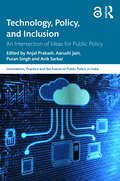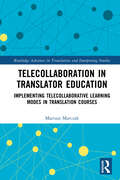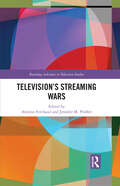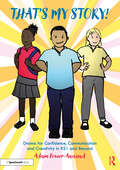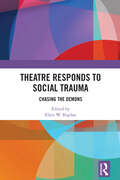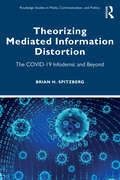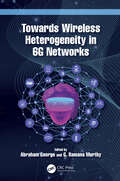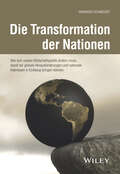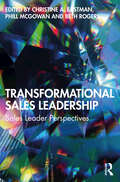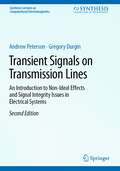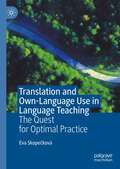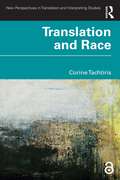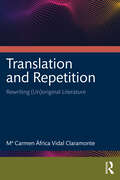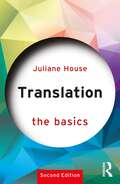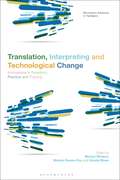- Table View
- List View
Technology, Policy, and Inclusion: An Intersection of Ideas for Public Policy (Innovations, Practice and the Future of Public Policy in India)
by Anjal Prakash, Aarushi Jain, Puran Singh, and Avik SarkarTechnology, Policy, and Inclusion looks at the intersections between public policy and technology in India. It explores the barriers in instituting effective governance and development and examines how these can be mitigated through technological interventions in developing countries. Increased digitisation of the economy has added to the development challenges in India and issues such as exclusion and social inequality. This volume stresses the need for governments to leverage technology to bring more vulnerable and marginalised groups into the fold of financial and social inclusion. It also focuses on the importance of regulation for a responsible integration of technologies and minimising risks. The book includes examples and case studies from different areas including management of the COVID-19 pandemic through digital means, real estate digital infrastructure, digital census, e-markets for farmers, and government interventions that use technology to deliver financial services in remote areas of the country. It also outlines various solutions for fostering equity and socio-economic development. Part of the Innovations, Practice and the Future of Public Policy in India series, this volume will be of interest to students and researchers of public policy, political science, development studies, and sociology as well as policy professionals and technocrats. This book is freely available as a downloadable Open Access PDF at http://www.taylorfrancis.com under a Creative Commons (CC-BY-NC-ND) 4.0 license.
Telecollaboration in Translator Education: Implementing Telecollaborative Learning Modes in Translation Courses (Routledge Advances in Translation and Interpreting Studies)
by Mariusz MarczakThis volume provides a comprehensive treatment of telecollaboration as a learning mode in translator education, surveying the state-of-the-art, exploring its distinctive challenges and affordances and outlining future directions in both theoretical and practical terms. The book begins with an overview of telecollaboration and its rise in prominence in today’s globalised world, one in which developments in technology have significantly impacted practices in professional translation and translator education. The volume highlights basic design types and assessment modes and their use in achieving competence-based learning outcomes, drawing on examples from seven telecollaboration projects. In incorporating real-life research, Marczak draws readers’ attention to not only the practical workings of different types of projects and their attendant challenges but also the opportunities for educators to diversify and optimize their instructional practices and for budding translators to build competence and better secure their future employability in the language service provision industry. This volume will be a valuable resource for students and researchers in translation studies, particularly those with an interest in translator education and translation technology, as well as stakeholders in the professional translation industry.
Telecollaboration in Translator Education: Implementing Telecollaborative Learning Modes in Translation Courses (Routledge Advances in Translation and Interpreting Studies)
by Mariusz MarczakThis volume provides a comprehensive treatment of telecollaboration as a learning mode in translator education, surveying the state-of-the-art, exploring its distinctive challenges and affordances and outlining future directions in both theoretical and practical terms. The book begins with an overview of telecollaboration and its rise in prominence in today’s globalised world, one in which developments in technology have significantly impacted practices in professional translation and translator education. The volume highlights basic design types and assessment modes and their use in achieving competence-based learning outcomes, drawing on examples from seven telecollaboration projects. In incorporating real-life research, Marczak draws readers’ attention to not only the practical workings of different types of projects and their attendant challenges but also the opportunities for educators to diversify and optimize their instructional practices and for budding translators to build competence and better secure their future employability in the language service provision industry. This volume will be a valuable resource for students and researchers in translation studies, particularly those with an interest in translator education and translation technology, as well as stakeholders in the professional translation industry.
Television’s Streaming Wars (Routledge Advances in Television Studies)
by Arienne Ferchaud Jennifer M. ProffittThis volume addresses contemporary debates and trends regarding the production and distribution, content, and audience engagement with the television streaming industry. The book interrogates the economics and structure of the industry, questions the types and diversity of content perpetuated on streaming services, and addresses how audiences engage with content from US and global perspectives and within various research paradigms. Chapters address television streaming wars, including the debates and trends in terms of its production and competition, diversity and growth of programming, and audience consumption, focusing on multiple platforms, content, and users. This timely and creative volume will interest students and scholars working in television studies, media industry studies, popular culture studies, audience studies, media psychology, critical cultural studies and media economics.
Television’s Streaming Wars (Routledge Advances in Television Studies)
This volume addresses contemporary debates and trends regarding the production and distribution, content, and audience engagement with the television streaming industry. The book interrogates the economics and structure of the industry, questions the types and diversity of content perpetuated on streaming services, and addresses how audiences engage with content from US and global perspectives and within various research paradigms. Chapters address television streaming wars, including the debates and trends in terms of its production and competition, diversity and growth of programming, and audience consumption, focusing on multiple platforms, content, and users. This timely and creative volume will interest students and scholars working in television studies, media industry studies, popular culture studies, audience studies, media psychology, critical cultural studies and media economics.
That's My Story!: Drama for Confidence, Communication and Creativity in KS1 and Beyond
by Adam Power-AnnandThe ability to communicate is an essential life skill for all children and young people and it underpins their social, emotional and educational development. If a child experiences a positive relationship with an adult listening carefully, they are more likely to constructively share their thoughts, feelings and their imaginative ideas.That’s My Story! places children’s imagined stories at the heart of their own development and provides a joyful, creative approach to support young children’s personal and social development and to encourage their communication. In this book you will find: Tried-and-tested drama games and activities that support communication and well-being, all adaptable to complement your current practice Guidance and advice on how to promote positive adult-child interactions Examples of creative interventions that support children’s communication development A celebration of the joy that comes with carefully listening to children’s own imagined stories Those of us who work with children can sense a tangible connection between how young children feel and how they communicate. This essential and practical resource will be valuable reading for primary teachers, teaching assistants, speech and language therapists, and drama practitioners, as well as outreach and education departments of theatre companies and other arts organisations.
That's My Story!: Drama for Confidence, Communication and Creativity in KS1 and Beyond
by Adam Power-AnnandThe ability to communicate is an essential life skill for all children and young people and it underpins their social, emotional and educational development. If a child experiences a positive relationship with an adult listening carefully, they are more likely to constructively share their thoughts, feelings and their imaginative ideas.That’s My Story! places children’s imagined stories at the heart of their own development and provides a joyful, creative approach to support young children’s personal and social development and to encourage their communication. In this book you will find: Tried-and-tested drama games and activities that support communication and well-being, all adaptable to complement your current practice Guidance and advice on how to promote positive adult-child interactions Examples of creative interventions that support children’s communication development A celebration of the joy that comes with carefully listening to children’s own imagined stories Those of us who work with children can sense a tangible connection between how young children feel and how they communicate. This essential and practical resource will be valuable reading for primary teachers, teaching assistants, speech and language therapists, and drama practitioners, as well as outreach and education departments of theatre companies and other arts organisations.
Theatre Responds to Social Trauma: Chasing the Demons (Routledge Series in Equity, Diversity, and Inclusion in Theatre and Performance)
This book is a collection of chapters by playwrights, directors, devisers, scholars, and educators whose praxis involves representing, theorizing, and performing social trauma.Chapters explore how psychic catastrophes and ruptures are often embedded in social systems of oppression and forged in zones of conflict within and across national borders. Through multiple lenses and diverse approaches, the authors examine the connections between collective trauma, social identity, and personal struggle. We look at the generational transmission of trauma, socially induced pathologies, and societal re-inscriptions of trauma, from mass incarceration to war-induced psychoses, from gendered violence through racist practices. Collective trauma may shape, protect, and preserve group identity, promoting a sense of cohesion and meaning, even as it shakes individuals through pain. Engaging with communities under significant stress through artistic practice offers a path towards reconstructing the meaning(s) of social trauma, making sense of the past, understanding the present, and re-visioning the future.The chapters combine theoretical and practical work, exploring the conceptual foundations and the artists’ processes as they interrogate the intersections of personal grief and communal mourning, through drama, poetry, and embodied performance.
Theatre Responds to Social Trauma: Chasing the Demons (Routledge Series in Equity, Diversity, and Inclusion in Theatre and Performance)
by Ellen W. KaplanThis book is a collection of chapters by playwrights, directors, devisers, scholars, and educators whose praxis involves representing, theorizing, and performing social trauma.Chapters explore how psychic catastrophes and ruptures are often embedded in social systems of oppression and forged in zones of conflict within and across national borders. Through multiple lenses and diverse approaches, the authors examine the connections between collective trauma, social identity, and personal struggle. We look at the generational transmission of trauma, socially induced pathologies, and societal re-inscriptions of trauma, from mass incarceration to war-induced psychoses, from gendered violence through racist practices. Collective trauma may shape, protect, and preserve group identity, promoting a sense of cohesion and meaning, even as it shakes individuals through pain. Engaging with communities under significant stress through artistic practice offers a path towards reconstructing the meaning(s) of social trauma, making sense of the past, understanding the present, and re-visioning the future.The chapters combine theoretical and practical work, exploring the conceptual foundations and the artists’ processes as they interrogate the intersections of personal grief and communal mourning, through drama, poetry, and embodied performance.
Theorizing Mediated Information Distortion: The COVID-19 Infodemic and Beyond (Routledge Studies in Media, Communication, and Politics)
by Brian H. SpitzbergThis book explores the phenomenon of distortion of information through media via the lens of the COVID-19 pandemic, and the ways in which relevant information distortion and virality have occurred in regard to the disease and its risks. Positing that the interrelated processes of misinformation, disinformation, fake news and conspiracy theories are related forms of distortion of information through media (DIM) and can only be understood through a multilevel theoretical model that incorporates message-based, individual difference, social network-based, societal and geotechnical factors, Brian H. Spitzberg develops an integrative, well-argued, and well-evidenced framework within which these issues can and should be addressed. This book offers a model for further research across such disciplines as communication, journalism/media studies, political science, sociology, cognitive psychology, social psychology, evolutionary psychology, public health, big data analytics, social network analytics, computational linguistics and geographic information sciences, and will interest researchers and students in those areas.
Theorizing Mediated Information Distortion: The COVID-19 Infodemic and Beyond (Routledge Studies in Media, Communication, and Politics)
by Brian H. SpitzbergThis book explores the phenomenon of distortion of information through media via the lens of the COVID-19 pandemic, and the ways in which relevant information distortion and virality have occurred in regard to the disease and its risks. Positing that the interrelated processes of misinformation, disinformation, fake news and conspiracy theories are related forms of distortion of information through media (DIM) and can only be understood through a multilevel theoretical model that incorporates message-based, individual difference, social network-based, societal and geotechnical factors, Brian H. Spitzberg develops an integrative, well-argued, and well-evidenced framework within which these issues can and should be addressed. This book offers a model for further research across such disciplines as communication, journalism/media studies, political science, sociology, cognitive psychology, social psychology, evolutionary psychology, public health, big data analytics, social network analytics, computational linguistics and geographic information sciences, and will interest researchers and students in those areas.
Towards Wireless Heterogeneity in 6G Networks
The connected world paradigm effectuated through the proliferation of mobile devices, Internet of Things (IoT), and the metaverse will offer novel services in the coming years that need anytime, anywhere, high-speed access. The success of this paradigm will highly depend on the ability of the devices to always obtain the optimal network connectivity for an application and on the seamless mobility of the devices. This book will discuss 6G concepts and architectures to support next-generation applications such as IoT, multiband devices, and high-speed mobile applications. IoT applications put forth significant challenges on the network in terms of spectrum utilization, latency, energy efficiency, large number of users, and supporting different application characteristics in terms of reliability, data rate, and latency.While the 5G network developmentwas motivated by the need for larger bandwidth and higher quality of service (QoS), 6G considerations are supporting many users with a wide application requirement, lowering network operating cost, and enhanced network flexibility. Network generations beyond 5G are expected to accommodate massive number of devices with the proliferation of connected devices concept in connected cars, industrial automation, medical devices, and consumer devices.This book will address the fundamental design consideration for 6G networks and beyond. There are many technical challenges that need to be explored in the next generation of networks, such as increased spectrum utilization, lower latency, higher data rates, accommodating more users, heterogeneous wireless connectivity, distributed algorithms, and device-centric connectivity due to diversified mobile environments and IoT application characteristics. Since 6G is a multidisciplinary topic, this book will primarily focus on aspects of device characteristics, wireless heterogeneity, traffic engineering, device-centric connectivity, and smartness of application.
Towards Wireless Heterogeneity in 6G Networks
by Abraham George G. Ramana MurthyThe connected world paradigm effectuated through the proliferation of mobile devices, Internet of Things (IoT), and the metaverse will offer novel services in the coming years that need anytime, anywhere, high-speed access. The success of this paradigm will highly depend on the ability of the devices to always obtain the optimal network connectivity for an application and on the seamless mobility of the devices. This book will discuss 6G concepts and architectures to support next-generation applications such as IoT, multiband devices, and high-speed mobile applications. IoT applications put forth significant challenges on the network in terms of spectrum utilization, latency, energy efficiency, large number of users, and supporting different application characteristics in terms of reliability, data rate, and latency.While the 5G network developmentwas motivated by the need for larger bandwidth and higher quality of service (QoS), 6G considerations are supporting many users with a wide application requirement, lowering network operating cost, and enhanced network flexibility. Network generations beyond 5G are expected to accommodate massive number of devices with the proliferation of connected devices concept in connected cars, industrial automation, medical devices, and consumer devices.This book will address the fundamental design consideration for 6G networks and beyond. There are many technical challenges that need to be explored in the next generation of networks, such as increased spectrum utilization, lower latency, higher data rates, accommodating more users, heterogeneous wireless connectivity, distributed algorithms, and device-centric connectivity due to diversified mobile environments and IoT application characteristics. Since 6G is a multidisciplinary topic, this book will primarily focus on aspects of device characteristics, wireless heterogeneity, traffic engineering, device-centric connectivity, and smartness of application.
Transformation der Nationen (AT)
by Reinhard SchneiderJahrzehntelang waren die technologisch fortgeschrittenen Länder des Westens die Nutznießer der Globalisierung auf Basis der von ihnen geschaffenen Wirtschaftsordnung. Jetzt ändern sich die geopolitischen und wirtschaftlichen Verhältnisse mit Wucht. Gleichzeitig hat sich in den letzten Jahren die Erkenntnis durchgesetzt, dass wir unsere Wirtschaft auf CO2-freies Wirtschaften umstellen müssen. Zudem altern viele Gesellschaften. Deutschland und Europa tun sich sichtlich dabei schwer, ihre Nationen zukunftsfähig zu gestalten. Gerade bei der passenden Wirtschaftspolitik hakt es. Reinhard Schneiders These ist: Es braucht in Deutschland und Europa dringend einen politischen, wirtschaftlichen und gesellschaftlichen Wandel. Diesen schaffen wir aber nur, wenn wir die Grundlagen unseres Wohlstands verstehen. Leider ist das Verständnis der wirtschaftlichen Zusammenhänge in der Politik und der breiten Bevölkerung oft lückenhaft und es kommt zu Fehleinschätzungen. Dies beginnt schon bei der mangelnden Unterscheidung zwischen Tätigkeiten, die Kosten für eine Gesellschaft auslösen, und Tätigkeiten, die Einkommen für eine Gesellschaft generieren. Eine wesentliche Ursache ist die Art, wie wir Wertschöpfung und Einkommen von Nationen bzw. Staaten wie Deutschland definieren und messen. Fest steht: Wenn Nationen ihren Wohlstand halten wollen, müssen sie konkurrenzfähig sein. Attraktive und konkurrenzfähige Produkte werden mittlerweile überall angeboten; bei Amazon ist man nur einen Klick vom weltweiten Angebot entfernt. Während die USA und China verstehen, dass sie ihr Einkommen steigern müssen, wenn sie mehr Wohlstand haben wollen, rümpfen die Europäer die Nase über den Neoliberalismus. Sie rufen lieber nach Geld vom Staat oder der EU zur Steigerung der Nachfrage. Auf diesem Weg werden Deutschland und Europa Gefahr laufen, abgehängt zu werden. Das Buch liefert eine längst überfällige Darstellung der Realität der Wirtschaft. Es soll helfen, richtige Entscheidungen zu treffen. Nur so gelingt uns, vor dem Hintergrund der aktuellen globalen Herausforderungen, der Wandel in eine erfolgreiche Zukunft - die Transformation der Nationen.
Transformational Sales Leadership: Sales Leader Perspectives
by Christine A. Eastman Phill McGowan Beth RogersTransformational Sales Leadership: Sales Leader Perspectives offers viewpoints from 12 leaders across the global sales industry, all of which challenge conventional sales models and promote visionary ways of thinking about sales and leadership.The leaders who share their professional stories in the book are from organizations including SAP, Google, Nationwide US, and Royal Caribbean, as well as their own practices, and they represent a new breed of salespeople who are increasingly sought after by organizations which need to transform their practices. They run teams, drive analytics, and improve operational excellence, and their careers rise or fall on getting the right KPIs. Their stories address solutions to age-old sales problems, but they bring a new perspective to the sales function in the digital age. The book focuses on what sales leaders need in order to be innovative. Specifically, the book shows you how to:• Coach sales people through disruption;• Leverage the most valuable habits for success; and• Provide for meaning and purpose in the hyper-connected and volatile sales industry.If you are a sales professional looking to succeed in challenging scenarios, the journeys recounted in this book demonstrate how the landscape of sales has changed and how thinking about sales differently can help you transform your career.
Transformational Sales Leadership: Sales Leader Perspectives
by Christine A. Eastman Phill McGowan Beth RogersTransformational Sales Leadership: Sales Leader Perspectives offers viewpoints from 12 leaders across the global sales industry, all of which challenge conventional sales models and promote visionary ways of thinking about sales and leadership.The leaders who share their professional stories in the book are from organizations including SAP, Google, Nationwide US, and Royal Caribbean, as well as their own practices, and they represent a new breed of salespeople who are increasingly sought after by organizations which need to transform their practices. They run teams, drive analytics, and improve operational excellence, and their careers rise or fall on getting the right KPIs. Their stories address solutions to age-old sales problems, but they bring a new perspective to the sales function in the digital age. The book focuses on what sales leaders need in order to be innovative. Specifically, the book shows you how to:• Coach sales people through disruption;• Leverage the most valuable habits for success; and• Provide for meaning and purpose in the hyper-connected and volatile sales industry.If you are a sales professional looking to succeed in challenging scenarios, the journeys recounted in this book demonstrate how the landscape of sales has changed and how thinking about sales differently can help you transform your career.
Transient Signals on Transmission Lines: An Introduction to Non-Ideal Effects and Signal Integrity Issues in Electrical Systems (Synthesis Lectures on Computational Electromagnetics)
by Andrew Peterson Gregory DurginThis book provides an introduction to transmission line effects in the time domain. Fundamentals including time of flight, impedance discontinuities, proper termination schemes, nonlinear and reactive loads, and crosstalk are considered. Required prerequisite knowledge is limited to conventional circuit theory. The material is tutorial for electrical and computer engineers on the topic of transient signals on transmission lines. Emphasis has been placed on aspects of the subject that have application to signal integrity and high-speed digital circuit design issues, including proper termination schemes to avoid impedance discontinuities, reactive and nonlinear loads, and an introduction to crosstalk.The coverage focuses on the very important topic of transmission line transients which have been de-emphasized in most current textbooks. This book is prepared to supplement traditional texts for advanced students studying electromagnetics and for a vast array of practicing electrical engineers, computer engineers and material scientists with interests in signal integrity and high-speed digital design.In this second edition, examples and new problems have been added throughout. A new chapter on differential transmission lines has also been incorporated
Translation and Own-Language Use in Language Teaching: The Quest for Optimal Practice
by Eva SkopečkováThis book reconsiders the role of translation and own-language use in the EFL (English as a Foreign Language) classroom. It shows prospective teachers how to use the learners’ own language and translation optimally. The author surveys current research about the EFL classroom and presents both a theoretical framework and a didactic model for using translation and learners’ mother tongues. This is done through an action research project, assessing the proposed didactic model for optimal translation practice in English Language teaching (OTP in ELT) through its integration into teacher education. The book will be of interest to students and researchers in the areas of Translation Studies and Applied Linguistics (particularly EFL, ESL, TEFL and TESOL), as well as educators and designers of pre-service training programmes for language teachers.
Translation and Race (New Perspectives in Translation and Interpreting Studies)
by Corine TachtirisTranslation and Race brings together translation studies with critical race studies for a long-overdue reckoning with race and racism in translation theory and practice. This book explores the "unbearable whiteness of translation" in the West that excludes scholars and translators of color from the field and also upholds racial inequities more broadly.Outlining relevant concepts from critical race studies, Translation and Race demonstrates how norms of translation theory and practice in the West actually derive from ideas rooted in white supremacy and other forms of racism. Chapters explore translation’s role in historical processes of racialization, racial capitalism and intellectual property, identity politics and Black translation praxis, the globalization of critical race studies, and ethical strategies for translating racist discourse. Beyond attempts to diversify the field of translation studies and the literary translation profession, this book ultimately calls for a radical transformation of translation theory and practice.This book is crucial reading for advanced students and scholars in translation studies, critical race and ethnic studies, and related areas, as well as for practicing translators.
Translation and Race (New Perspectives in Translation and Interpreting Studies)
by Corine TachtirisTranslation and Race brings together translation studies with critical race studies for a long-overdue reckoning with race and racism in translation theory and practice. This book explores the "unbearable whiteness of translation" in the West that excludes scholars and translators of color from the field and also upholds racial inequities more broadly.Outlining relevant concepts from critical race studies, Translation and Race demonstrates how norms of translation theory and practice in the West actually derive from ideas rooted in white supremacy and other forms of racism. Chapters explore translation’s role in historical processes of racialization, racial capitalism and intellectual property, identity politics and Black translation praxis, the globalization of critical race studies, and ethical strategies for translating racist discourse. Beyond attempts to diversify the field of translation studies and the literary translation profession, this book ultimately calls for a radical transformation of translation theory and practice.This book is crucial reading for advanced students and scholars in translation studies, critical race and ethnic studies, and related areas, as well as for practicing translators.
Translation and Repetition: Rewriting (Un)original Literature
by Mª Carmen Vidal ClaramonteTranslation and Repetition: Rewriting (Un)original Literature offers a new and original perspective in translation studies by considering creative repetition from the perspective of the translator. This is done by analyzing so-called "unoriginal literature" and thus expanding the definition of translation. In Western thought, repetition has long been regarded as something negative, as a kind of cliché, stereotype or automatism that is the opposite of creation. On the other hand, in the eyes of many contemporary philosophers from Wittgenstein and Derrida to Deleuze and Guattari, repetition is more about difference. It involves rewriting stories initially told in other contexts so that they acquire a different perspective. In this sense, repeating is often a political act. Repetition is a creative impulse for the making of what is new. Repetition as iteration is understood in this book as an action that recognizes the creative and critical potential of copying. The author analyzes how our time understands originality and authorship differently from past eras, and how the new philosophical ways of approaching repetition imply a new way of understanding the concept of originality and authorship. Deconstruction of these notions also implies subverting the traditional ways of approaching translation. This is vital reading for all courses on literary translation, comparative literature, and literature in translation within translation studies and literature.
Translation and Repetition: Rewriting (Un)original Literature
by Mª Carmen Vidal ClaramonteTranslation and Repetition: Rewriting (Un)original Literature offers a new and original perspective in translation studies by considering creative repetition from the perspective of the translator. This is done by analyzing so-called "unoriginal literature" and thus expanding the definition of translation. In Western thought, repetition has long been regarded as something negative, as a kind of cliché, stereotype or automatism that is the opposite of creation. On the other hand, in the eyes of many contemporary philosophers from Wittgenstein and Derrida to Deleuze and Guattari, repetition is more about difference. It involves rewriting stories initially told in other contexts so that they acquire a different perspective. In this sense, repeating is often a political act. Repetition is a creative impulse for the making of what is new. Repetition as iteration is understood in this book as an action that recognizes the creative and critical potential of copying. The author analyzes how our time understands originality and authorship differently from past eras, and how the new philosophical ways of approaching repetition imply a new way of understanding the concept of originality and authorship. Deconstruction of these notions also implies subverting the traditional ways of approaching translation. This is vital reading for all courses on literary translation, comparative literature, and literature in translation within translation studies and literature.
Translation: The Basics (The Basics)
by Juliane HouseTranslation: The Basics is an accessible and comprehensive introduction to the study of translation. This revised edition includes two new chapters on culturally embedded concepts and translation in global business. All references have been updated with additional references and new quotes added. Combining traditional text-based views with the context of translation in its widest sense, it presents an integrated approach to methodology in order to critically address influences such as power and gender, as well as cultural, ethical, political and ideological issues. This book answers such questions as: How can translations be approached? Do social issues and culture play a part in translations? How does a translation relate to the original work? What effect has globalization had on translation? What are the core concerns of professional translators? Key theoretical issues are explained with reference to a range of case studies, suggestions for further reading and a detailed glossary of terms, making this the essential guide for anyone studying translation and translation studies.
Translation: The Basics (The Basics)
by Juliane HouseTranslation: The Basics is an accessible and comprehensive introduction to the study of translation. This revised edition includes two new chapters on culturally embedded concepts and translation in global business. All references have been updated with additional references and new quotes added. Combining traditional text-based views with the context of translation in its widest sense, it presents an integrated approach to methodology in order to critically address influences such as power and gender, as well as cultural, ethical, political and ideological issues. This book answers such questions as: How can translations be approached? Do social issues and culture play a part in translations? How does a translation relate to the original work? What effect has globalization had on translation? What are the core concerns of professional translators? Key theoretical issues are explained with reference to a range of case studies, suggestions for further reading and a detailed glossary of terms, making this the essential guide for anyone studying translation and translation studies.
Translation, Interpreting and Technological Change: Innovations in Research, Practice and Training (Bloomsbury Advances in Translation)
by Marion Winters, Sharon Deane-Cox and Ursula BöserThe digital era is characterised by technological advances that increase the speed and breadth of knowledge turnover within the economy and society. This book examines the impact of these technological advances on translation and interpreting and how new technologies are changing the very nature of language and communication. Reflecting on the innovations in research, practice and training that are associated with this turbulent landscape, chapters consider what these shifts mean for translators and interpreters. Technological changes interact in increasingly complex and pivotal ways with demographic shifts, caused by war, economic globalisation, changing social structures and patterns of mobility, environmental crises, and other factors. As such, researchers face new and often cross-disciplinary fields of inquiry, practitioners face the need to acquire and adopt novel skills and approaches, and trainers face the need to train students for working in a rapidly changing landscape of communication technology. This book brings together advances and challenges from the different but intertwined perspectives of translation and interpreting to examine how the field is changing in this rapidly evolving environment.
